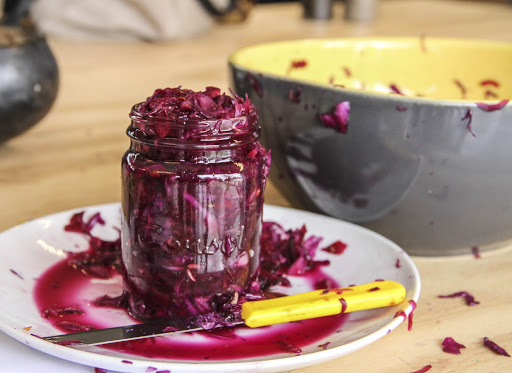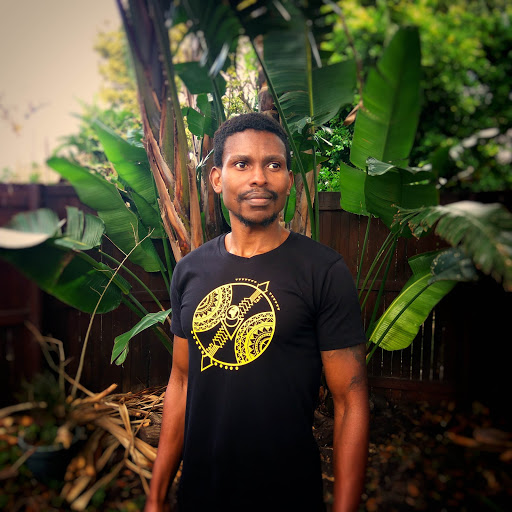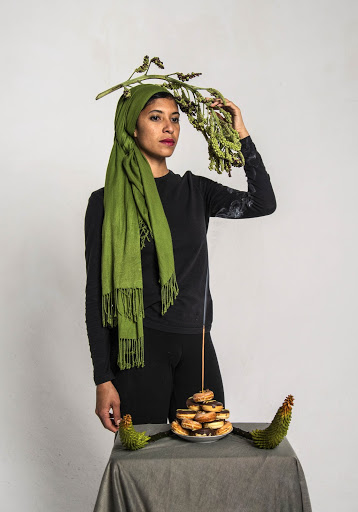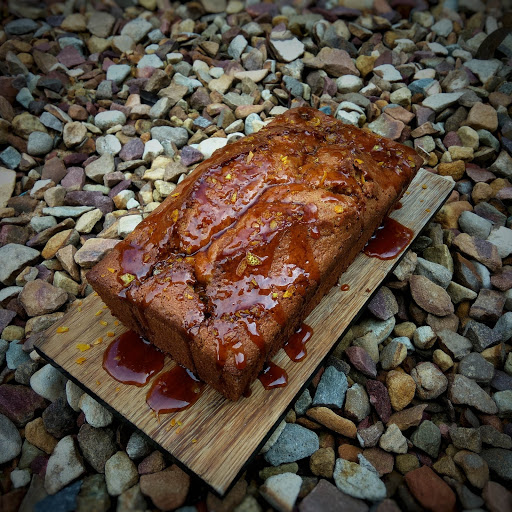A wild soda with gooseberries. (Photo: Zayaan Khan)
At a panel on food and culture at the Food Dialogues 2020 virtual event, journalist and author of the book Curry: Stories & Recipes Across South Africa, Ishay Govender-Ypma, introduced the discussion.
“The act of eating reveals an incredible amount of information about a person’s immediate circumstances: their class, their place in society and the broader world, their religious and ritualistic practices, as well as their place in history …
“At every juncture of the act of eating … we are inadvertently announcing class and economic status, our education around food choices, our place in community and ultimately — our identity.”
Clearly and unequivocally, Govender-Ypma bound food with identity.
Loosely, Zayaan Khan and Tapiwa Guzha might be called indigenous food activists, individuals whose work is driven by the tether that connects food to identity, among other factors. But ask them how they identify in this space and they go by different names.
 Rooibos kombucha, smoked impepho cordial, lemon leaf soda, and a firethorn berry cider. (Photo: Tapiwa Guzha)
Rooibos kombucha, smoked impepho cordial, lemon leaf soda, and a firethorn berry cider. (Photo: Tapiwa Guzha)
Khan calls herself an indigenous food revivalist. Her engagement with food preparation and nourishment is often steeped in a sense of ceremony. This permeation is evident in how she might go about recipe development:
1. Access a deep spiritual part of yourself;
2. Be in a Zen mode;
3. Ask for consistency from your ancestors;
4. Light a fire in recognition;
5. Make an offering;
6. Open your dreamscape;
7. Work through your dreams;
8. Understand your landscape;
9. Get to know everyone who lives in the same space as you: plants, insects, soils and water; and
10. Play with the plants in terms of food.
 Khan’s approach to food preparation and nourishment is often steeped in ceremony. (Photo: Zayaan Khan)
Khan’s approach to food preparation and nourishment is often steeped in ceremony. (Photo: Zayaan Khan)
This recipe is atypical — dissimilar to those you would expect to find flipping through a cookbook. This preparation doesn’t speak to measurements, utensils, or an ingredients list — at least, not yet. Instead it invites an opening up, a stepping into an awareness of self; an appeal to be mindful of the terroir in which food is cultivated and how it journeys before and after harvest.
“It is about getting into that spiritual space where you are guided. A lot of my approach is a deeply spiritual practice — political, but spiritual … I’ve had a lot of responses in my dreams about which way to work with foods, especially foods that are not easily eaten. And because I also have a very soft synaesthetic experience of food, I experience it vividly, even empathetically. I experience it in colour, in shape. This helps me have a beautifully triangulated approach to food,” she says, while admitting that her process is deep because it requires her to see and acknowledge food to tell its backstory, a technique she recognises as part of her purpose.
And Guzha? He refers to himself as a cultural rehabilitator. His interest is in promoting how Africans view and value themselves; a current of reclamation and restoration around ego, beliefs and identities.
Guzha is the innovator behind Tapi Tapi ice cream, a platform he uses as an education initiative about the continent’s flavours, its food and its cultures. He plays around with unlikely indigenous ingredients in his desserts to help the people who purchase his products rethink their ideas of the role and value of the foods they grew up on. Customers are introduced to new tastes that flip flavour profiles on their head: savoury repurposed into sweet, sweet tweaked with tartness — an exploration in food essence.
Guzha says preserving and re-incorporating various indigenous food and cooking technologies into the kitchen is urgent. Food tethers self to identity. Its erasure breaks that link.
 Tapiwa Guzha considers himself a cultural rehabilitator, assisting with a restoration of beliefs and identities. (Supplied)
Tapiwa Guzha considers himself a cultural rehabilitator, assisting with a restoration of beliefs and identities. (Supplied)
“I’m developing an ice-cream tasting ceremony that lets people share some of their culture through [the culture of eating],” he says. “People live alone more these days. So some of the respect you put into the process of eating is gone because there’s no one to observe you doing it.”
The ceremony involves cleansing and saying certain words of acknowledgement, coupled with the burning of impepho. In fact, he is developing impepho paper that doesn’t burn as quickly as the plant, and can last longer for his customers.
Conservation as survival
In her book Eat Ting, a collaboration with food writer and culinary anthropologist Anna Trapido, Mpho Tshukudu writes: “Since we are what we eat, if we ignore taste preferences and familial food fondness, we become someone else. Essentially, the existing diet books serve up the idea that Africans need to change who they are in order to lose weight and gain health … Don’t disregard many traditional black South African recipes that are not only delicious but also ideal weapons in the fight against excess body fat. When food traditions are lost, so too are medically sound strategies for health.”
Bringing in the new lies, in a sense, in preserving the old; in tapping into the reservoir of deep knowledge passed down orally from previous generations. In Trapido’s introduction she writes that the book “is a way to fall in love with great ancient African tastes in a manner that improves the quality of all modern lives”.
Using the past as scaffolding to layer on to, build, and expand upon is an approach that resonates with Guzha. He views indigenous food innovation as a process that anyone can be involved in, facilitated by the guiding question: How can you as a person who is part of your culture contribute to that story?
For Guzha, discounting the food one grows up on because modern conventions call for it misses the point. Instead: “It’s about saying I still love those things, but also want to contribute to the conversation —add my twist to it, add to the culture, add to the history. To be an active participant in your own culture, as opposed to an observer of your culture.
“There’s this phrase I heard: ‘Tradition is peer pressure from dead people.’ I really believe in that. What it takes to add to that story for me is being understanding and respectful of the past without feeling beholden to it for the sake of holding onto it.”
Still, he recognises the importance of looking to the past for establishing a sense of identity. “If you have no idea of your past, you look back but can’t form a sense of pride in who you are, where you’re coming from and where you’re trying to go,” he says.
“Remembering the past, honouring the past and protecting that memory is important … Because of the history we have on the continent, it’s necessary to preserve our legacies in a lot more tangible ways.”
 For Khan, understanding which food is available; where to source it and how to forage ethically and legally, requires being rooted in indigenous knowledge. (Photo: Neo Baepi)
For Khan, understanding which food is available; where to source it and how to forage ethically and legally, requires being rooted in indigenous knowledge. (Photo: Neo Baepi)
There is a push-pull tension between the dynamic nature of novelty and the more lethargic pace of tradition; an interplay in that interrelation that speaks to a certain antagonism.
Khan says that there is much to unravel and unpack, highlighting that often when someone thinks they are bringing in novel foods those foods are ancient. “It’s the same with fermentation: people assume that these ways and methods are new, but they’re supremely ancient,” she says. “So when you’re working with those ancient foods and the ancients are with you — the ancestors are with you — it’s very empowered and powerful spiritual work.”
Khan says that innovation is a response; a coping mechanism triggered by genocide. “We’re dealing with the vast majority who are no longer with us, and a lot of severing of knowledge and culture through coloniality and apartheid-structured systems.
 Edibile clay cake with citrus caramel glaze. (Photo: Tapiwa Guzha)
Edibile clay cake with citrus caramel glaze. (Photo: Tapiwa Guzha)
“The identity of indigenous people [when it comes to] food is somewhat broken. So to innovate means to understand what foods were eaten back in the day. To understand what foods are still available… The knowledge of plants, for example, vanished, but the plants themselves did not.”
This understanding of which food is available; where to source this produce; how to forage ethically and legally; and how to farm sustainably requires an injection of time, money and the availability of resources. It requires research and tapping into existing networks rooted in indigenous knowledge. As Khan mentioned in her recipe, it calls seekers to “understand your landscape” and “get to know everyone who lives in the same space as you”.
This approach can be consuming. So too, the try-fail-amend-repeat cycle of experimenting with food. Expressing the slog of it all, Guzha captions an Instagram post in which he’s developing a new recipe using edible clay baked into a fluffy cake with a citrus caramel glaze: “There is a lot of experimentation, failed trial runs, wasted ingredients and all other manner of challenges that go into developing a recipe, dish, menu and indeed a collection of recipes …
“Loads of food that will never see the light of day because, though delicious, it wouldn’t tickle your visual fancy. Add on to that, the years of training, research, tutelage, oil burns, kitchen fires, dedication that goes into amassing a set of skills that allows a person to take the ordinary and create a brief moment of extraordinary.”